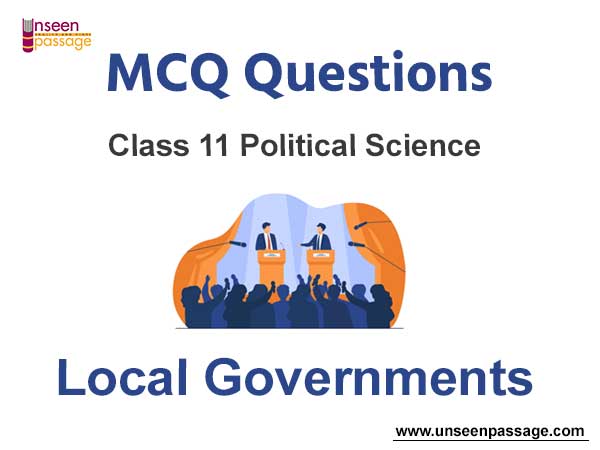Local Governments MCQ Questions Class 11 Political Science
Please refer to Chapter 8 Local Governments MCQ Class 11 Political Science with answers below. These multiple-choice questions have been prepared based on the latest NCERT book for Class 11 Political Science. Students should refer to MCQ Questions for Class 11 Political Science with Answers to score more marks in Grade 11 Political Science exams. Students should read the chapter Local Governments and then attempt the following objective questions.
MCQ Questions Class 11 Political Science Chapter 8 Local Governments
Local Governments MCQ Class 11 Political Science provided below covers all important topics given in this chapter. These MCQs will help you to properly prepare for exams.
Question. One-third of the total number of seats of Panchayats are reserved for:
(a) Backward Classes
(b) Scheduled Castes
(c) Women belonging to Scheduled Castes
(d) Women
Answer
D
Question. The first State in the country to adopt the Panchayati Raj System on 2nd October 1959 was
(a) Andhra Pradesh
(b) Rajasthan
(c) Bihar
(d) Orrisa
Answer
B
Question. Which of the following Amendments to Constitution of India grants a Constitutional status to ‘Panchayati Raj System’?
(a) 71 st Amendment
(b) 72 nd Amendment
(c) 73 rd Amendment
(d) 75 th Amendment
Answer
C
Question. Who is the Chief Officer in Panchayati Samiti
(a) Dissemination officer
(b) Development officer
(c) Accountant
(d) Office Superintendent
Answer
B
Question. In India, the women Sarpanch at the Gram Panchayat level are
(a) 5000
(b) Less than 20,000
(c) Approx. 50,000
(d) More than 80,000
Answer
D
Question. Which Constitutional Article defines the duration of the Panchayat—
(a) Article 243N
(b) Article 243O
(c) Article 243E
(d) Article 243B
Answer
C
Question. The National Panchayati Diwas is celebrated on –
(a) 10th April
(b) 14th April
(c) 24th April
(d) 25th April
Answer
C
Question. In 1989, P.K. Thungon Committee recommended the constitutional recognition of
(a) Local government bodies
(b) Consumer courts
(c) Planning commission
(d) Financial commission for states
Answer
A
Question. The term of each Panchayat body is
(a) 3 months
(b) 2 years
(c) 6 months
(d) 5 years
Answer
D
Question. Which of the following Rural Local Government system exists in Haryana?
(a) Two-tier system
(b) One-tier system
(c) Three-tier system
(d) Four-tier system.
Answer
C
Question. According to 73rd Amendment, the tenure of Panchayats in all states is:
(a) Six years
(b) Three years
(c) Five years
(d) Four years
Answer
C
Question. ______ government is about the government closest to the common people.
(a) Local
(b) Union
(c) State
(d) Provincial
Answer
A
Question. Which of the following is not an institution of Rural Local Government?
(a) Panchayat
(b) Zila Parishad
(c) Municipal Corporation
(d) Gram Sabha
Answer
C
Question. Which city of Haryana has Municipal Corporation?
(a) Gurgaon
(b) Faridabad
(c) Ambala
(d) Karnal
Answer
B
Question. Which of the following played important role in the development of local government?
(a) Willim Bentick
(b) Lord Rippon
(c) Lord Cornwalis
(d) Macculary
Answer
B
Question. The amendment of the constitution can be initiated in
(a) President’s office
(b) Rajya Sabha
(c) Lok Sabha
(d) Any Houses of the Parliament
Answer
D
Question. Who functions as Secretary to the District Planning Committee?
(a) President of District Panchayat
(b) Member nominated by the state government
(c) Member of a muncipality
(d) District Collector
Answer
D
Question. When was Panchayati Raj introduced in India?
(a) November 4, 1953
(b) October 2, 1959
(c) September 23, 1960
(d) October 5, 1958
Answer
B
Question. Which state has no Panchayati Raj institution at all?
(a) Mizoram
(b) Manipur
(c) Arunachal Pradesh
(d) Tripura
Answer
D
Question. In the total revenue collection of India, the contribution of
the rural local bodies is
(a) 0.10%
(b) 0.18%
(c) 0.20%
(d) 0.24%
Answer
D
Question. Panchayati Raj institutions came into existence under the:
(a) 42nd and 43rd Amendment Acts
(b) 86th and 87th Amendment Acts
(c) 63rd and 64th Amendment Acts
(d) 73rd and 74th Amendment Acts
Answer
D
Question. Which of the following is/are NOT the objectives of Panchayat Extension to Scheduled Areas (PESA) Act, 1996?
(a) To provide self-rule to the tribal population
(b) To preserve the traditions and customs of tribal communities
(c) To establish an autonomous council in the tribal areas
(d) To extend the provisions of Part IX in the Schedule Areas with certain modification
Answer
D
Question. In Bolivia, the law that decentralized the power at the local level is
(a) Presidential Law.
(b) Decentralized Law.
(c) Popular Participation Law.
(d) Popular Decentralized Law.
Answer
C
Question. If a Panchayat is dissolved, elections are to be held within ________..
(a) Six months from the date of dissolution
(b) Twelve months from the date of dissolution
(c) Two months from the date of dissolution
(d) One month from the date of dissolution
Answer
A
Question. Panchayati Raj Subject falls under which List of the Constitution ?
(a) Union List
(b) State List
(c) Concurrent List
(d) None of the above
Answer
B
Question. Panchayats have been established in:
(a) Villages
(b) Town
(c) Small city
(d) Big city
Answer
A
Question. The maximum duration of Municipalities is
(a) 3 years
(b) 5 years
(c) 4 years
(d) 6 years
Answer
B

We hope you liked the above Local Governments MCQ Class 11 Political Science. In case you have any questions please put them in the comments box below and our teachers will provide you a response.
